There are many conferences each year. Unfortunately a lot of them are filled with boring, self-promoting stuff. At least that is how I feel about it. What about you? Do you have the same experience?
It can be different.
Just one week ago I attended a great conference in The Netherlands: Conversion Hotel! It was held on an island to make sure no one would dare to leave in between the sessions and parties. ;-)
The speakers, organization, audience and parties were awesome.
Watch this short intro video to get an impression of this event:
I combine the insights of this conference with some additional tips from my side.
Seven Great Speakers and Keynotes
A short overview of the talks in chronological order:
(including links to speaker’s Twitter profiles (must-follow) and Slideshare presentations)
- Angie Schottmuller – How to convert SEO traffic?
- Michael Aagaard – CRO+ by tweaking your copy
- Brian Massey – Define and understand your visitors
- Craig Sullivan – These A/B-tests appear to be bullshit
- Bart Schutz – Brain attention & motivation
- Karl Gilis – Growth hacking tips that work
- Stephen Anderson – From Paths to Sandboxes
Learnings from Angie Schottmuller
A great woman from the US who knows her stuff and loves Star Wars. :-)
1. Dive into Webmaster Tools for Valuable Data
We all know that our keywords are not visible anymore in Google Analytics.
By looking at your Webmaster Tools data you can find out things like:
- What pages drive the highest CTR (what works and what doesn’t work) and learn from that
- What pages need a lift (pages that rank around # 11 or 12 in the SERPs; CTR boost to rank them on page 1)
2. Optimize Your Organic Search Conversion Funnel as a Whole
All too often people optimize organic search on just one or two spots. Learn to optimize for the complete conversion funnel at the user’s/keyword query level:
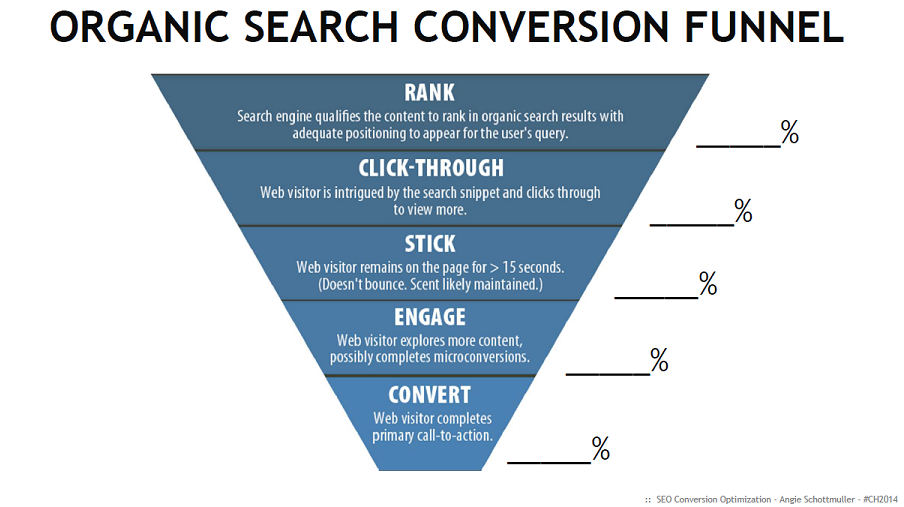 And of course, start of with your main keyword phrases.
And of course, start of with your main keyword phrases.
3. Focus on Valuable Metrics
A while ago I wrote two posts on “great metrics” you might want to check out:
– 8 SEO metrics that matter
– 7 Tips to Discover Great Metrics for Your Business
Too often I come across companies that include useless metrics on their KPI list.
Check Angie’s slide deck and this quote from Ben Yoskovitz:
“If a metric won’t change the way you behave, then it’s a BAD metric.”
And please be honest to yourself when deciding about your metrics.
4. Think Beyond the Funnel
This slide from Bryan Eisenberg (tip: Buyer Legends) really nails it:
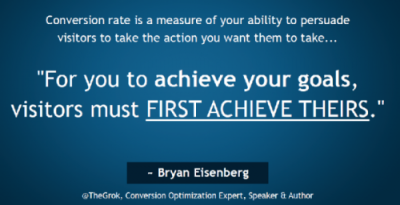 So think about what your visitors like to achieve before counting the money!
So think about what your visitors like to achieve before counting the money!
The good old 4Q survey is a great place to start and derive great insights.
5. Apply Adjusted Bounce Rate Measures
In the past I wrote a post about bounce rates and rough industry standards on this metric.
This post was focused on the standard metric in Google Analytics. If people bounce, it means:
“They came, they puked, they left – with no measured interaction on your site”
Angie did a great job and shared that this metric actually doesn’t tell the complete story. On default Google Analytics count bounces independent of time on page, scrolling behavior etc.
Make sure to grap this piece of code to implement adjusted bounce rate on your website.
It will help you to get a more accurate view about the performance of your website.
Some measures/events to track with this include:
- 5 Seconds+ sessions
- 15 Seconds+ sessions
- Scrolls beyond the fold
- Scrolls to bottom
A big thanks to Angie for putting this together!
Learnings from Michael Aagaard
An energetic, inspiring copy and test junkie from Denmark, terrific speaker!
6. Focus on Optimizing Decisions – Not Web Copy
Michael has shown some great examples on newsletter effectiveness.
How often do you read:
Join over 5.000 subscribers and that’s it! Ok it shows (claims) there are already a lot of readers there.
But what’s in it for me?
So why not say Join over 5.000 subscribers and get FREE Optimization Tips every week.
A lot more powerful right?
Make sure to always test your value propostion. Don’t take for granted that something will work better.
7. Know Your Conversion Goals
Or course you like people to buy your products or apply for your services.
However, there is more. There is a lot more going on on your website so carefully define your conversion goals.
This post about macro and micro goals might come in handy for you.
8. Perform No Test Without Hypothesizing
If you are running an A/B test, you need to know why you are doing it.
Do some solid quantitative and qualitative research to form a valid hypothesis.
If you own a small website with low traffic, qualitative research is even more important.
Tip for now or later, watch this interview of Aartjan van Arkel with Michael Aagaard:
- By changing … into … I can get more prospects to … and thus increase … .
- By adding … , I can get more prospects to … and thus increase … .
- By removing … , I can get more prospects to … and thus increase … .
9. Increase Clarity to Persuade
It’s ok to be creative when designing your landing pages. However, very often clarity beats creativity. If something is not completely clear, a lot of people won’t convert on your website.
This is how Michael thinks about Conversion Copywriting:
So find the right balance I would say!
10. Let the Data Tell You What to Test
From one side quantitative tools like Google Analytics will reveal the spots on your website where you should test. In general high traffic pages that are important to your conversion goals are a great place to start.
If you are running an Ecommerce site, you could test this segment:
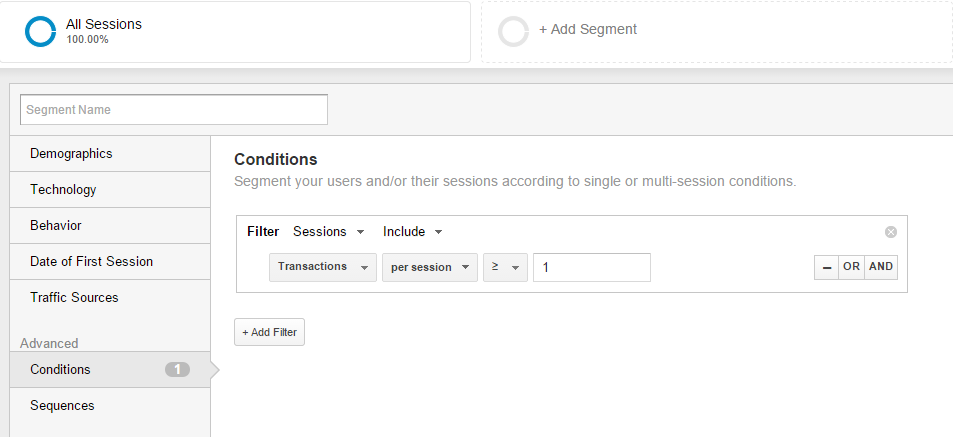 Dig into the pages (besides your sales funnel) that drive conversions and optimize them with A/B testing.
Dig into the pages (besides your sales funnel) that drive conversions and optimize them with A/B testing.
On the other hand, use different qualitative tools to derive great ideas for your testing.
Important take away: don’t try to guess what/where to test by yourself. Every once in a while that’s ok, but trust reliable data sources most of the time.
Read this post about the trilogy of Analytics tools if you are more interested about combining different data sources to extract insights.
Learnings from Brian Massey
Well, I will always remember Brian as the lab coat guy and conversion scientist. Just check out a short video from him on Unbounce.com to see how he performs in his white coat.
Enough about that, let’s continue with some learnings.
11. Design Your Website With Different People in Mind
Consumers are all different. Some people see one page and buy; others view many pages and come back three times before they eventually decide to buy.
This matrix shows different personalities (“persona” types):
- Competitive: people that take a very short time and view a couple of pages before they decide to buy from you or not
- Spontaneous: people that very quickly decide (often already on the landing page) whether they buy or not
- Methodical: people who take a long time (lots of research and comparisons) before they decide whether they should buy
- Humanist: people whose actions are mainly driven on emotional factors (reviews, social aspects) and like to find the information on the landing page
So, it is important to keep these segments in mind when designing your website and landing pages. Your copy should suit them all.
12. Different Browser Segments Need Different Attention
What I mean here is that browser versions can often be tied to a particular group of people.
- Chrome and Firefox users: often characterized as more technically savvy
- Safari users; tend to have a higher than average income
- Internet Explorer users: older people :-)
This is just a simple rule of thumb. And beware things might change in the future.
What does this have to do with Conversion Optimization?
Well, sometimes it might be better to show different variants of your pages to different browser segments. This can lead to higher returns in the end.
13. Test Your Internal Site Search Effectiveness
Very often there is a correlation between site search and conversion rate.
People who use the internal site search box tend to convert better than people who don’t.
The question is:
“Do site searchers buy more or do buyers search more?”
Brian had some interesting cases where persuading more site visitors to search led to higher conversions overall.
My advice: run some split tests yourself!
Learnings from Craig Sullivan
A great personality from the UK. A smart, funny person who has a great deal of knowledge and can spin some great tracks at night parties. :-)
Read his Conversion Hotel review here.
And we have learned a lot from him.
14. Make a Money Model
Both if you are working as a consultant or simply as a Conversion Expert for one particular company this point makes sense.
Before starting a test it is a good thing to calculate the possible impact of your testing efforts. And test it against resources needed and difficulty of implementation.
It does make a huge difference whether a landing page drives 100 visitors per day or 1.000 visitors a day.
If the latter is the case, you could drive a huge amount of extra revenue with a relatively small uplift in conversion rate.
His tip on this one: think like a store owner.
15. Gather Your Insights From Many Different Places
There is always a time vs money debate, but in general the more trustworthy sources upon which you formulate your hypothesis the better.
A nice framework shows you different data environments to think about:
Besides this make sure to brainstorm your test ideas with a wide range of people in the organization. Don’t just focus on usability experts or simply online minded people.
16. Integrate Your Test Tool with Analytics
There are many different test tools that are used nowadays.
In my experience two great tools on A/B testing are:
- Visual Website Optimizer (learn how to integrate with Google Analytics)
- Optimizely (learn how to integrate with Google Analytics)
An Analytics integration helps to:
- Investigate test problems
- Segment your results (traffic source, visitor type, country, browser, device type)
- Uncover the averages of your test results
17. Calculate Your Test Length Up Front
If you only receive 100 visitors on your website a day you should refrain from running quantitave A/B tests. It will simply take too long to get a reliable winner.
Two resources that help you to calculate A/B split test duration:
18. Don’t Call Your Test Too Early
95% Significance and (almost) every test tool will send you a message: you’ve got a winner. Oh boy, this is very bad actually.
Many times you don’t have enough conversions per variant yet. As a rule of thumb, 250 conversions per variant (segment) as a minimum.
Significance level = related to false positives (you conclude you have a winner, but it is not the truth)
Power level = related to false negatives (there is a winner, but you don’t recognize it)
Well, better to have false negatives than false positives. However, you should try to minimize the chances on both.
I highly recommend to use this online calculator (click on image to go to A/B Testguide website):
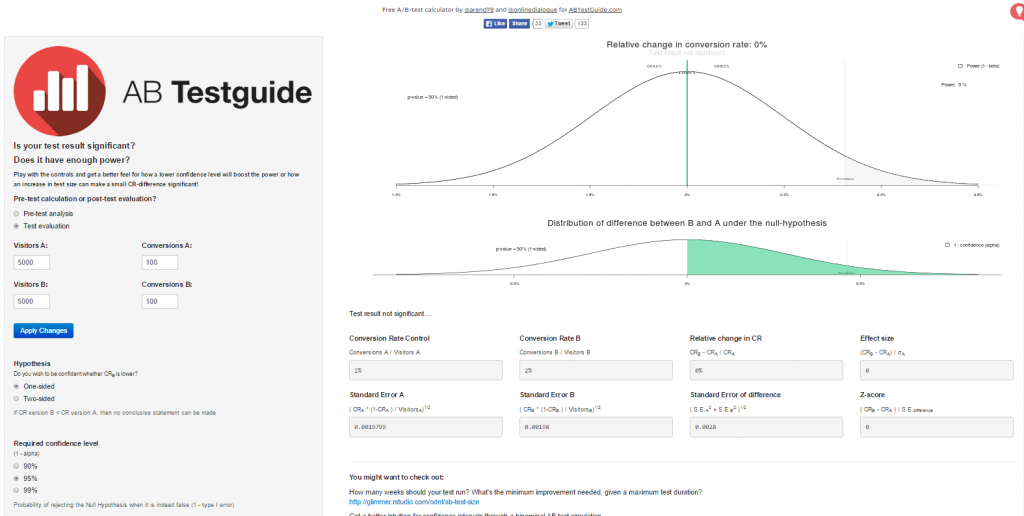 Four related great articles that are worth reading:
Four related great articles that are worth reading:
- Conversion XL (Statistical Significance Does Not Equal Validity)
- A clear picture of power and significance in A/B tests
- Understanding the Cycles in your site
- Why every Internet Marketer Should be a Statiscian
19. Eight Stopping Rules
- Minimum test duration is two business cycles and one purchase cycle
- Minimum 250 conversions per variant
- More conversions are needed when relative difference is small
- Always test full weeks (so don’t start a test on Monday and stop on Friday)
- Run a test length calculator
- Set your run test time
- Analyse the data
- Run over when you don’t have enough data
20. Carefully Segment Your Results
On the overall level it might happen that your test doesn’t show a winner.
However, if you haven’t segmented your test upfront, you really should dive into your Analytics (segments).
Segments might cancel each other out -> result: no visible winner!
Read Craig’s slideshare to derive some more insights!
Learnings from Bart Schutz
Bart, what a guy and from The Netherlands as well! What about him? Well, he knows a LOT about consumer psychology and Conversion Optimization and… he went swimming in the ocean at five (or was it six?) in the morning.
But what a performance!
21. Human Have a Dual Processing Brain
We have two different systems of which one is more active at certain times than the other and vice versa. You should know how to deal with them to make someone convert.
In short a comparison between both systems:
System 1 (emotional)
- Fast and always on
- Subconscious
- Large capacity
- Effortless
- Automatic
System 2 (rational)
- Slow and lazy
- Conscious
- Requires attention
- Effortful
- Control
22. Square of Intoxication
Bart shares some really great stuff on Wheel of Persuasion (must-read) and built a variant on this one for his #CH2014 presentation:
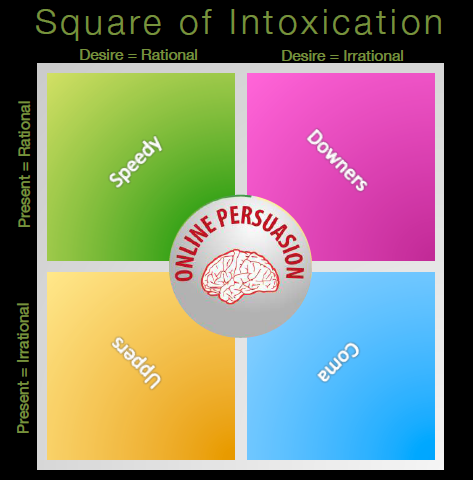 In short, in each unique situation you need a different method (based on system 1 or 2 or combined) to persuade a visitor to a desired action (next step, subscription, buying decision).
In short, in each unique situation you need a different method (based on system 1 or 2 or combined) to persuade a visitor to a desired action (next step, subscription, buying decision).
Make sure to check out this podcast interview with Bart to learn more about his famous tactics.
23. Visual Cueing
Our brain is so easily influenced, so someone gazing at a call-to-action, special arrows etc. very often lead to higher conversions.
Just test it out!
A good example is shown below:
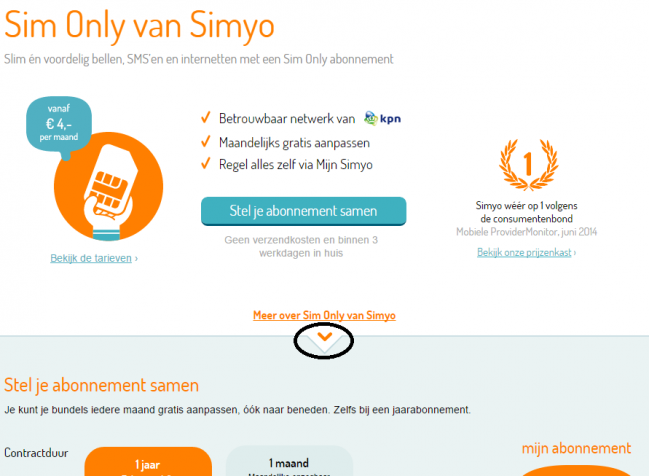 24. Your Rational System Gets Easily Depleted
24. Your Rational System Gets Easily Depleted
If you feed someone’s brain with very difficult information or numbers, that system is most often drained very quickly.
After this happens you can more easily target someone on the emotional side and earn some $$$.
25. Combine The Best of Both Worlds
If you really want to grow your business and not just your conversion rate, you need to focus on two things:
- Digital data (quantitative and qualitative)
- Persuasion psychology (Bart’s website)
Learnings from Karl Gilis
Oh man, he came on stage on Sunday morning after two great night parties. But what a performance, another great speaker and performer!
26. Remove Your Sliders
In his experience sliders are so bad… And only applicable when they are just image sliders without conveying separate messages.
Thank you Karl, just take a look at my homepage, you killed it! :-)
He did a lot of tests and static images tend to outperform sliders, both in clicks as well as conversions!
27. Remove Your Stock Photos
How many website do use stock photos instead of real, suitable pictures? Well, even the big brands use them a lot.
As always, test everything.
In this case, start with your most important landing pages and A/B test your images.
28. Remove Big Headers
Another great tip! A lot of websites do have big headers so that the actual content and/or call-to-action is under the fold.
Small headers are great, but try to avoid the big ones.
Nike is doing a great job; as you can see they use a small header/navigation. In this way users’ attention is drawn upon the product and call-to-action.
However, this image is not supporting their message. So a proper A/B test might bring some additional value and conversions for them!
29. Use Bullet Lists
Many websites and landing pages are cluttered with a lot of content.
Of course there are still people that carefully read the words on your landing page. However, many savvy web visitors scan for words and the most important points on your website.
Guide your visitors through your website with easy-to-scan content.
Bullet lists are a great way to convey your message and USP’s!
30. Remove Clutter in Your Sales Funnel
In general it is a best practice to remove any content that distracts your visitors from their goal.
Especially important in your sales funnel.
Think about it, your audience finally made it to your sales funnel and then they are confronted with lots of useless stuff and get distracted and leave.
Extra tip: be careful with voucher codes. People tend to go looking for them on the web if they don’t have any. They might not come back to your website after their search. Again, you lost one potential customer! And be aware of shady affiliates if you are running an affiliate program.
31. Repeat Your CTA at the End of Your Page
The majority of people who are really interested in your product will scroll down to read more on what you have to offer. Especially when selling high-involvement products people want to consume enough information before deciding to buy.
You do want to make it easy for them to order from you.
I encourage your to navigate to Basecamp.com. There are doing a great job on their website!
Learnings from Stephen Anderson
Stephen shared some great things with us in the last keynote of the conference. It went far beyond A/B testing and primarily addressed the following:
“How can we use psychology to design more fun, engaging and effective interactions”
BONUS 32. Paths and Sandboxes
He really did a great job and made us think about paths and sandboxes. Take your time to read through his presentation; it’s hard to summarize his keynote in a few learnings.
Paths: designed to lead people along, for better and worse. In terms of a conversion: your purchase funnel is a path for sure.
Sandboxes: more like a platform where you can have some paths inside. For example Twitter. You might like to gain more followers, interact with other people about specific topics, just socialize, show what you are doing.
Sometimes you have a goal, sometimes you don’t. There is no clear path.
Sandboxes enhance “playful behaviour” and creativity.
Two questions to ask yourself:
“Are you designing paths or sandboxes?”
“Are you following a path or playing in a sandbox?”
Well, with most things in life I prefer a sandbox, but certainly I do follow some paths.
Enough about me, take some time to think about it.
A few great websites to add to your reading list:
Well, if you came this far, I am very happy! :-)
You have just absorbed 3.099 words that contain tips and learnings from my CRO experience at one of the most beautiful spots in The Netherlands.
If you feel this conference would be a great fit for you, I highly recommend to sign-up for early bird prices notifications of Conversion Hotel here.
Do you have anything to add of say? I am glad to read and respond to your comments.
One last thing... Make sure to get my automated Google Analytics 4 Audit Tool. It contains 30 key health checks on the GA4 Setup.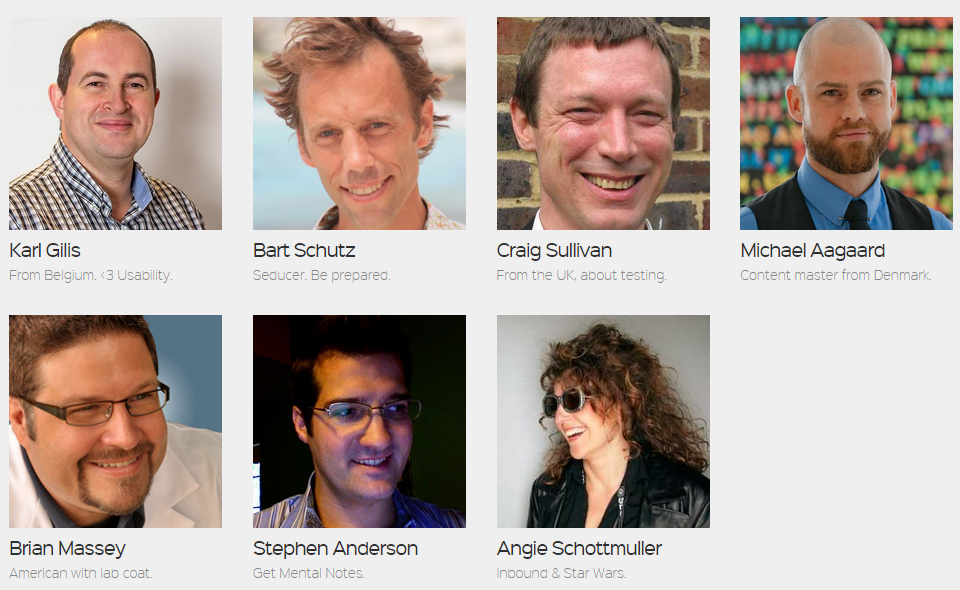
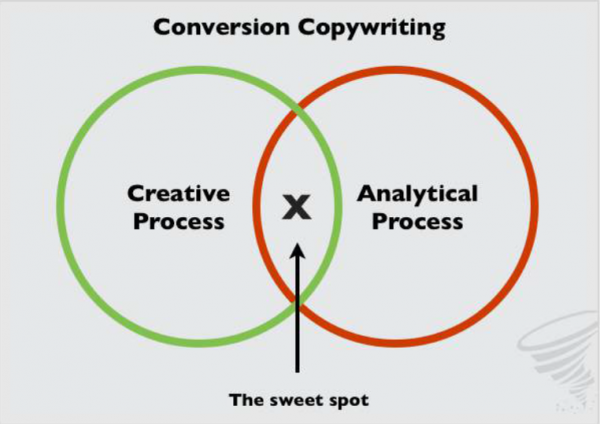
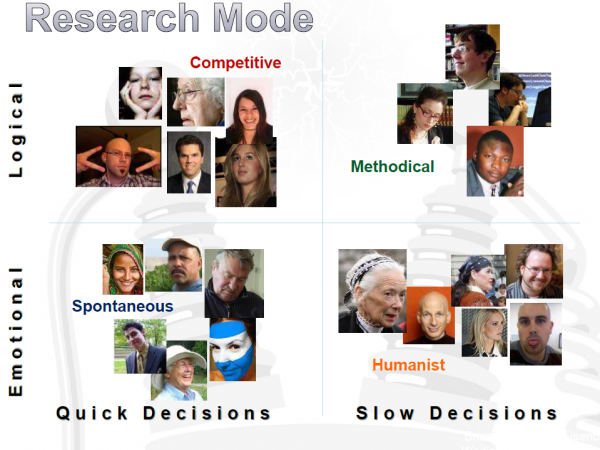
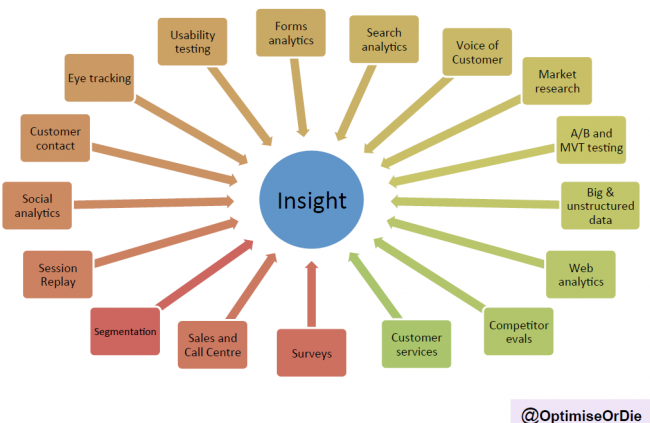
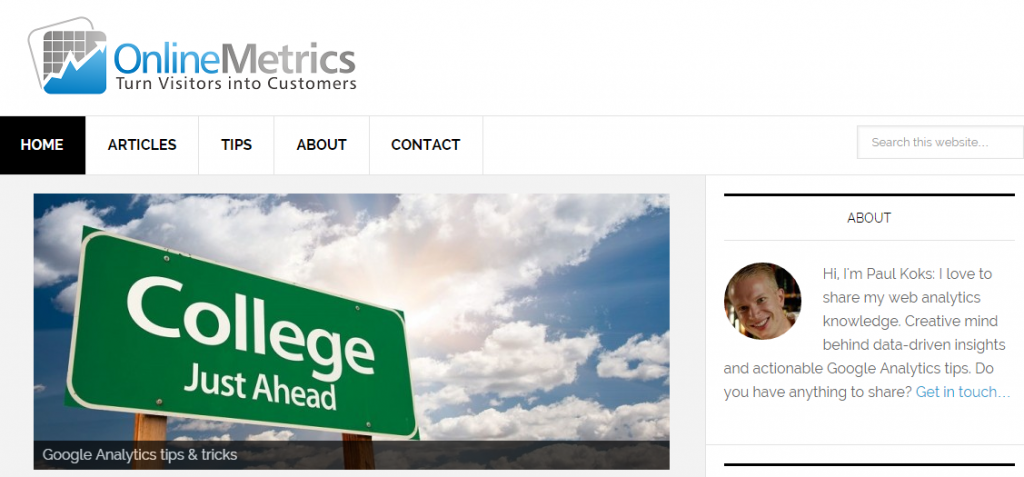

Great collection of actionable insights, Paul! I love that you included screenshots of the slides for added visual value. =)
Thanks Angie! 3.000 words without pictures would be boring. :-)
Good article. And oh boy, did I love that weekend!.
But my ‘kill big headers’ seems to be misunderstood quite often.
The Nike example you give, is a good example of a small header. Look at how little space the navigation takes, so all attention goes to the product and the call-to-action.
Although I think the image is not the best choice. The text reads ”Discover our shopping guide- the best gifts for men, woman and kids’. The image is not supporting that message.
So yes, Nike should do an AB-test…
Hell yeah, it was a great weekend Karl!
And thanks a lot for your comment. I have made a few changes to #28 to explain the header tip in the correct way.
I know I am late to the party but for your #8 “Do some solid quantitative and qualitative research to form a valid hypothesis.” It is actually reverse. First you create assumptions, then created outcomes based on those assumptions – only then you formulate your hypothesis under which you analyze available data (to see if any data already exists to support or dismiss it). If there is incomplete data, then you go after and generate (ie spend money to get) new data.
Thanks for your comment Maxim. Both methods can work, but I get your point; this article is based on proven methods of others in the field. Cheers, Paul